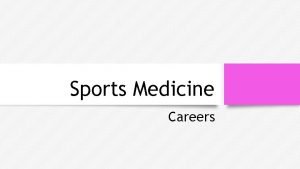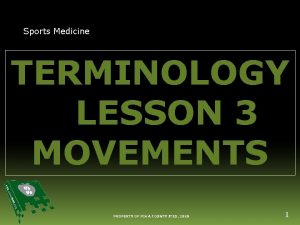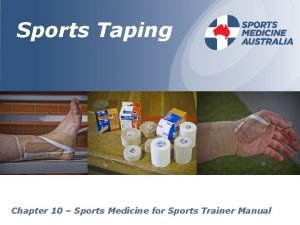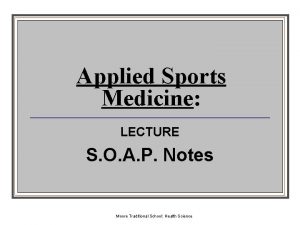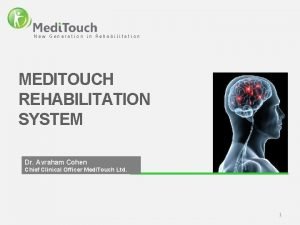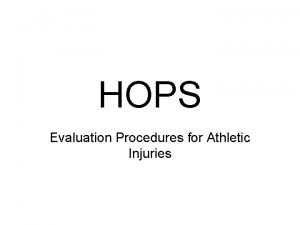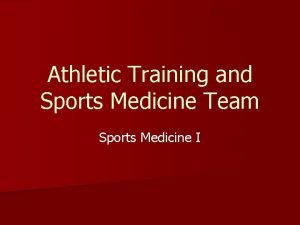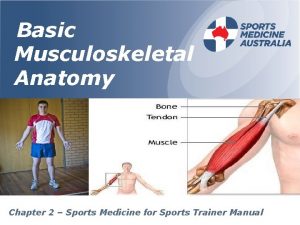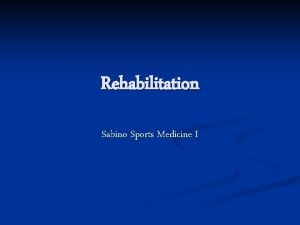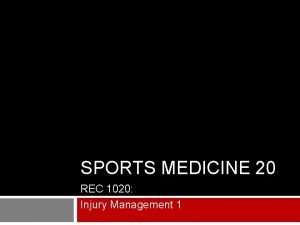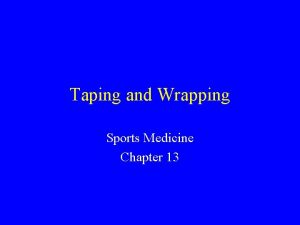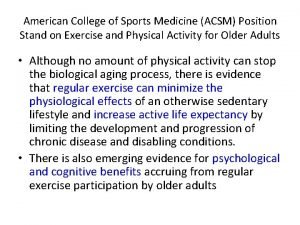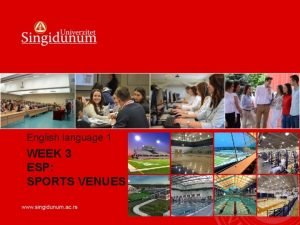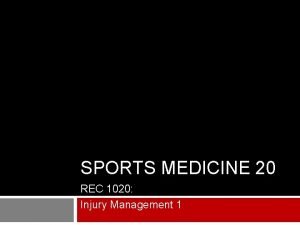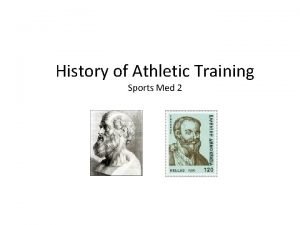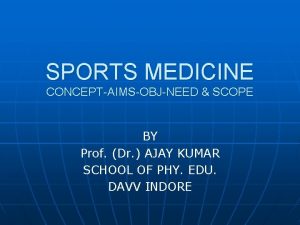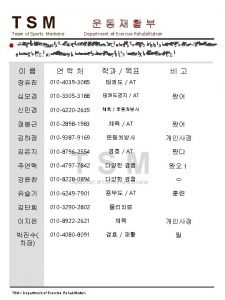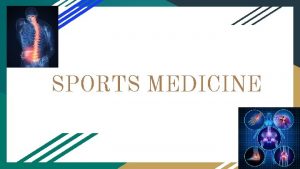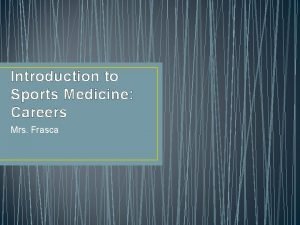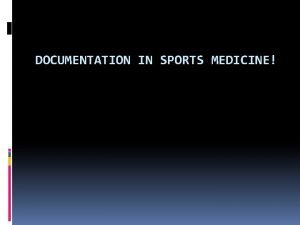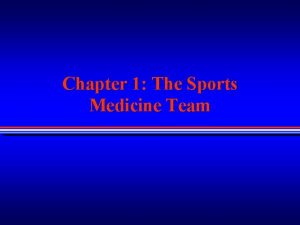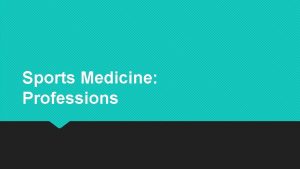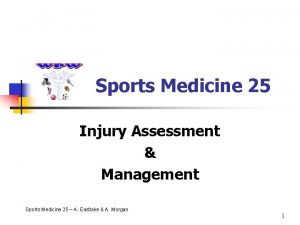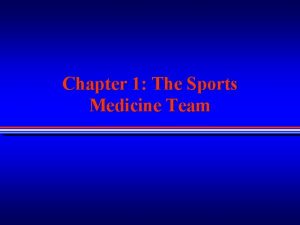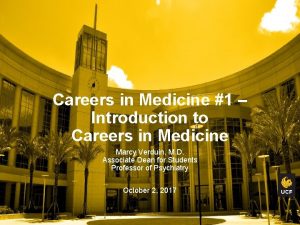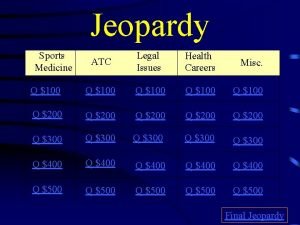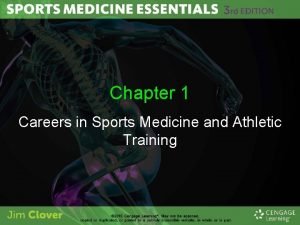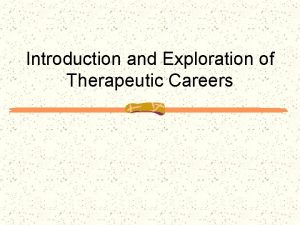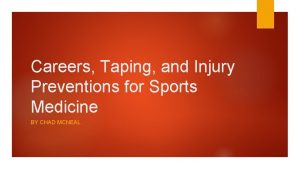Careers in Sports Medicine Sports medicine is a


















- Slides: 18

Careers in Sports Medicine

Sports medicine is a multidisciplinary approach for those seriously involved in sport, involving a variety of professionals, such as family and team doctors, physician assistants, certified athletic trainers, and physical therapists. Sports medicine was first recognized as a specialty in the 20 th century The American College of Sports Medicine was founded in 1954, promoting broadly trained physicians as an athlete’s first contact when treating an injury True sports medicine specialists have training that allows them to specifically address the needs of the athlete Athletes today commonly participate in strenuous exercise and intense athletic competition, which inherently carries a high level of risk With the expansion of professional athletics and the large number of participants at the college & high school levels, the importance of competition & performance has never been greater. Injury is often devastating to these individuals

Professions associated with sports medicine and others associated with athletic make up the Athlete’s Circle of Care Family & Team Doctor: Physicians promote lifelong fitness and wellness Two years of additional training through accredited subspecialty programs in sports medicine is common Additional training comes from continuing education and participation in sports medicine associations Ideally, a balance of care between the family doctor & the sports medicine physician specialist will provide the athlete with the most complete information and treatment.

Professions associated with sports medicine and others associated with athletic make up the Athlete’s Circle of Care Physician Assistant A recognized profession since the 1960’s, the physician assistant provides the extension of consumer access to health services by extending the time and skills of the physician. Duties include diagnostic and therapeutic patient care and in most states the prescribing of medication.

Professions associated with sports medicine and others associated with athletic make up the Athlete’s Circle of Care Physical Therapist Physical therapists specialize in a wide variety of areas in addition to sports medicine, including pediatrics, orthopedics, aquatic therapy, wound care, women’s health, and many others Physical therapists can be found in a variety of health care facilities, such as hospitals, schools, and fitness facilities

Professions associated with sports medicine and others associated with athletic make up the Athlete’s Circle of Care Physical Therapy Assistant Patient care is provided along with the physical therapist Duties include developing treatment plans, documenting treatment progress, and modifying treatment established by the physical therapist as patients recover

Professions associated with sports medicine and others associated with athletic make up the Athlete’s Circle of Care Chiropractor Spinal manipulation is used instead of drugs or surgery to promote the body’s natural healing process Chiropractors provide conservative management of neuromuscular disorders for back pain, neck pain, and headaches

Professions associated with sports medicine and others associated with athletic make up the Athlete’s Circle of Care Massage Therapists One of the oldest methods of providing relief of pain and discomfort, massage today has become important in promoting wellness and reducing stress Massage therapists work along with physicians, nurses, and physical therapists in the promotion of health and healing

Professions associated with sports medicine and others associated with athletic make up the Athlete’s Circle of Care Certified Strength and Conditioning Specialist/Personal Trainer Fitness instructors monitor and modify the athlete’s conditioning and strength training Certified Strength and Conditioning Specialist (CSCS) programs identify individuals who possess the knowledge and skills to design and implement safe and effective strength and conditioning programs

Professions associated with sports medicine and others associated with athletic make up the Athlete’s Circle of Care Sports Nutritionists develop correct diets for athletic competitors and instruct athletes on supplements and dietary aids Improvement in performance can be achieved through special diets geared toward specific athletic events

Professions associated with sports medicine and others associated with athletic make up the Athlete’s Circle of Care Sports Psychologist Sports psychologists are specially trained in athletic motivation and performance, using goal setting, imagery, and other techniques to give athletes an edge Sports psychologists can be found in clinical settings, educational institutions, private practice, and employed by professional sports teams

Professions associated with sports medicine and others associated with athletic make up the Athlete’s Circle of Care Coach At all levels, from young league competitions to professional sports teams, the coach teaches athletes how to compete without injury Good communication between the coach, athlete, and certified athletic trainer will ensure the best care for all athletes

Professions associated with sports medicine and others associated with athletic make up the Athlete’s Circle of Care Certified Athletic Trainer Athletic Training is the rendering of specialized care to those individuals involved in exercise and athletics Responsibilities include prevention, recognition, evaluation, care and rehabilitation of injuries The AMA recognizes athletic training as an allied health profession Title IX prohibits discrimination on the basis of sex from participation in athletics in schools, greatly increasing the number of female athletes ATC’s are an integral part of the athletic healthcare team in secondary schools, colleges, and universities, clinics, professional sports programs, and industrial settings Certified Athletic Trainers typically work beyond the typical work day and often exceed 40 hours per week

Professions associated with sports medicine and others associated with athletic make up the Athlete’s Circle of Care Certified Athletic Trainer ATC’s must abide by the rules and procedures of their certifying organization (NATABOC) and the state licensure or certification Failure to act in accordance with these rules can result in disciplinary action or termination The National Athletic Trainer’s Association (NATA) is the largest certifying organization in the United States and is the governing body for all ATC’s Minimum education requirement in a Bachelor’s Degree Major areas of study are athletic training, physical education, or exercise science Training includes anatomy, physiology, biomechanics, exercise physiology, athletic training, nutrition, and psychology/counseling

Professions associated with sports medicine and others associated with athletic make up the Athlete’s Circle of Care Certified Athletic Trainer A certification test is administered by the NATABOC consisting of multiple choice questions, a practical evaluation, and a written simulation Regional and State Trainer’s Associations are found in most US states and provide educational opportunities for ATC’s

Athlete’s Bill of Rights The Athlete’s Bill of Rights is a series of standards that include the right to: Have fun through sports Participate at a level commensurate with their maturity level Qualified adult leadership Participate in a safe and healthy environment Competent care and treatment of injuries Share the leadership and decision making of their sport Participate in a sport regardless of ability and income level Proper preparation for participation Equal opportunity to strive for success Be treated with dignity Say “No”

Liability and Risk Management Hippocratic Oath: “I will use treatment to help the sick according to my ability and judgement, but I will never use it to injure or wrong them. ” Anyone who works outside of his or her scope of practice and expertise can be found negligent and, therefore, liable for his or her actions. Liability insurance can help avoid financial disaster

Liability and Risk Management To avoid possible lawsuits, Certified Athletic Trainers should take certain precautions Work within scope of knowledge and expertise Keep proper documentation and maintain accurate records Follow proper training room rules and procedures Always have adequate training room supervision Keep in close contact with coaches, administration, and parents of athletes Inspect practices and game facilities daily Establish a return-to-play protocol Involve team physician in all aspects of the program Establish an advisory program with members of all involved parties Establish and practice an emergency action plan
 Sports medicine careers
Sports medicine careers Sports medicine terminology
Sports medicine terminology Sports medicine taping techniques
Sports medicine taping techniques Soap sports medicine
Soap sports medicine Meditouch israel
Meditouch israel H.o.p.s. athletic training
H.o.p.s. athletic training Sports medicine umbrella
Sports medicine umbrella Chapter 2 sports medicine
Chapter 2 sports medicine Meditouch sports medicine
Meditouch sports medicine Objective of sports medicine
Objective of sports medicine Shin splint tape wrap
Shin splint tape wrap Hops assessment
Hops assessment Acsm position stand
Acsm position stand Sports venues vocabulary
Sports venues vocabulary Orec-1020
Orec-1020 Athletic training sports medicine
Athletic training sports medicine Scope of sports medicine
Scope of sports medicine Healthcare and the healthcare team chapter 2
Healthcare and the healthcare team chapter 2 Sports medicine team definition
Sports medicine team definition
